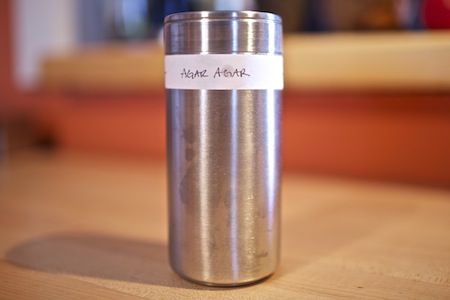After a recent (& mindblowing) meal at
Corton, I've been extra curious about utilizing 'modern' ingredients in the kitchen. The quotes are due to the fact that many of these ingredients -such as agar agar and carrageenan- have been used for thousands of years, but they are now lending themselves to some truly innovative applications in the kitchen. Though some of these products are hard to find many happen to be available
right here in the Cooking District Store.

We had a number of different gels throughout the courses of the Corton tasting menu, many of them no doubt set with agar agar. Gels are the most common use for agar agar. It's amazingly versatile stuff-it must be heated to hydrate, then cooled to set. However, if it's re-heated (up to 85ºC) the gel will still hold. This makes it remarkably useful for a number of applications where gelatin would simply melt again. But these gelling properties can be used for more than setting a simple gel. They can be used to clarify a liquid to a consommé like transparency.
We conducted our first try with OJ. To begin, get all of your mise en place in order:
- 500g OJ
- 250g OJ (separate from your first 500g)
- 1.5g Agar Agar
- Cheesecloth
- Gram Scale, good to a tenth of a gram
- Ice Bath
- Whisk
- Strainer Setup
- Saucepot
Agar agar is a very powerful hydrocolloid -meaning just a little bit can drastically change the viscosity of a liquid, which is exactly why we use it. This is also why we need a gram scale capable of measuring down to one tenth of a gram. For this application, we use a concentration of just .2% agar agar to liquid (e.g. 2 grams agar agar for 1000g of liquid) so a tenth of a gram can make a noticeable difference. Basically what we're going to do is make a very loose gel with the orange juice and agar agar, then break this gel up with the whisk, and finally strain out the 'curds' as FCI's Dave Arnold likes to call them. As you'll see, the strained liquid is not only crystal clear, but produces a high yield and remains super flavorful.
To get started, pour the 250g of OJ into your saucepot and then whisk in the agar agar. Put the pot over heat and bring to a simmer to hydrate ('activate') the agar agar. It's helpful to let the OJ/agar solution simmer for a minute or two to ensure the agar agar is fully hydrated. Now, slowly add the remaining 500g of OJ to pot -in the process dropping the temperature and retaining the fresh flavor of most of the OJ- all while being careful not to let the temp drop below 35ºC. If it gets too cold while mixing the rest of the OJ in, the liquid will start to set before everything's incorporated.
Once the remaining juice is incorporated, move the solution to the ice bath to set. The video above quickly shows the viscosity you can expect to see once the orange juice has gelled.
Once your OJ has cooled and set, break it apart with the whisk. The gel is so fragile that once whisked, it will appear almost as liquid as before the agar was added. Pour this into a cheesecloth lined chinois and you will quickly start to see clarified juice collecting at the bottom of your container.
The results are fantastic. Flavor is great. Yield is high-I didn't weigh my results but there's no doubt that very little was left in the strainer. And the clarity is undeniable, as you can see in the image below. As for applications of clear juice (remember, you don't
need to use OJ), that's entirely up to you. Immediately we thought cocktails, but there are limitless applications.
Source (& huge thanks to):
Cooking Issues
Where to get Agar Agar:
Cooking District Store